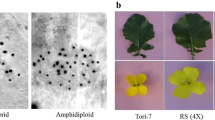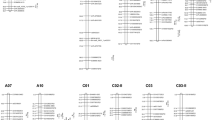Abstract
The present investigation was aimed to study the performance of F1 progenies of crosses between Brassica carinata A. Braun and Brassica rapa L. considering their morphological characters, agronomic traits and yield attributes. Increased vegetative growth in F1 progenies over their parents was observed. F1 progeny exhibited wider ranges of variations compared to the female parents for all characters studied. F1 progenies had taller plants and larger flowers than the female parent B. carinata. Average pollen fertility in the F1 progeny was lower than female parent. F1 progeny from the cross of Brassica carinata × Brassica rapa var.BAU M.91 had comparatively higher percentages of pollen fertility as well as siliqua setting. Number of seeds per siliqua were found to be lower than their female parent. Mean seed weight per plant in the F1 progenies was lower than the parents. Days to flowering in the F1 progenies were in between the parents and closer to the B. rapa parent. F1 progeny from the cross of Brassica carinata × Brassica rapa var. BAU M.91 were found to be promising considering morphological characters, agronomic traits, pollen fertility, yield attributes like percentage of fully developed seed, seed weight etc. These F1 progenies could be evaluated in the subsequent generations to select the stable and desirable Brassica breeding lines for the development of synthetic hexaploid (AABBCC) Brassica with traits of economic importance.



Similar content being viewed by others
References
Arnold ML (1997) Natural hybridization and evolution. Oxford University Press, New York
Choudhary BR, Joshi P, Singh K (2000) Synthesis, morphology and cytogenetics of Raphanofortii (TTRR, 2n=38): a new amphidiploid of hybrid Brassica tournefortii (TT, 2n=20) x Raphanus caudatus (RR, 2n=18). Theor Appl Genet 101(5–6):990–999
Chrungu B, Verma N, Mohanty A, Pradhan A, Shivanna KR (1999) Production and characterization of interspecific hybrids between Brassica maurorum and crop brassicas. Theor Appl Genet 98(3–4):608–613
Getinet A, Rakow G, Downey RK (1996) Agronomic performance and seed quality of Ethiopian mustard in Saskatchewan. Can J Plant Sci 76:387–392
Gomez-Campo C, Prakash S (1999) Origin and domestication. In: Go´mez-Campo C (ed) Biology of Brassica goenospecies. Elsevier, Amsterdam, pp 33–58.
Heslop-Harrison J, Heslop-Harrison Y (1970) Evaluation of pollen viability by enzymatically induced fluorescence: intracellular hydrolysis of fluorescein diacetate. Stain Technol 45:115–120
Jiang Y, Tian E, Li R, Chen L, Meng J (2007) Genetic diversity of Brassica carinata with emphasis on the inter-specific crossability with B. rapa. Plant Breeding 126:487–491
Karim MM, Siddika A, Tonu NN, Hossain DM, Meah MB, Kawanabe T, Fujimoto R, Okazaki K (2014) Production of high yield short duration Brassica napus by interspecific hybridization between B. oleracea and B. rapa. Breed Sci 63:495–502
Katche E, Quezada-Martinez D, Ihien Katche E, Vasquez-Teuber P, Mason AS (2019) interspecific hybridization for Brassica crop improvement. Crop Breed Genet Genom 1:e190007
Kho YO, Baer J (1968) Observing pollen tubes by means of fluorescence. Euphytica 17:198–302
Lage J, Trethowan RM (2008) CIMMYT’s use of synthetic hexaploid wheat in breeding for adaptation to rainfed environments globally. Aust J Agric Res 59:461–469
Leitch I, Bennett M (1997) Polyploidy in angiosperms. Trends Genet 2:470–476
Leitch AR, Leitch IJ (2008) Genomic plasticity and the diversity of polyploid plants. Science 320:481–483
Levin DA (1983) Polyploidy and novelty in flowering plants. Am Nat 122(1):470–476
Levin DA (2002) The role of chromosomal change in plant evolution. Oxford University Press, New York
Lewis WH (1980) Polyploidy: biological relevance. Plenum Press, New York
Lichtenzveig J, Abbo S, Nerd A, Tel-Zur N, Mizrahi Y (2000) Cytology and mating systems in the climbing cacti Hylocereus and Selenicereus. Am J Bot 87:1058–1065
Malek MA, Rahman L, Das ML, Hassan L (2006) Development of interspecific hybrids between Brassica carinata and B rapa (B campestris). Bangladesh J Agric Sci 33(1):21–25
Malek MA, Rahman L, Hassan L, Uddin MI, Rafii MY, Ismail MR (2012) Studies on some morphological characters and yield attributes of synthetic Brassica hexaploids and their parents. Afr J Biotechnol 11(57):12030–12039
McGrath JM, Quiros CF (1990) Generation of alien chromosome addition lines from synthetic Brassica napus: morphology, cytology, fertility, and chromosome transmission. Genome 33:374–383
Meng J, Shi S, Gan L, Li Z, Qu X (1998a) The production of yellow seeded Brassica napus (AACC) through crossing interspecific hybrids of B. campestris (AA) and B. carinata (BBCC) with B. napus. Euphytica 103:329–333
Meng J, Shi S, Li G, Li Z, Qu X (1998b) The production of yellow seeded Brassica napus (AACC) through crossing interspecific hybrids of B. campestris (AA) and B. carinata (BBCC) with B. napus. Euphytica 103:329–333
Musgrave M (2000) Realizing the potential rapid-cycling Brassica as a model system for use in plant biology research. J Plant Growth Regul 19:314–325
Nelson M, Mason A, Castello M-C, Thomson L, Yan G, Cowling W (2009) Microspore culture preferentially selects unreduced (2n) gametes from an interspecific hybrid of Brassica napus L. 9 Brassica carinata Braun. Theor Appl Genet 119:497–505
Nicolas SD, Leflon M, Liu Z, Eber F, Chelysheva L, Coriton O, Che`vre AM, Jenczewski E, (2008) Chromosome ‘speed dating’ during meiosis of polyploid Brassica hybrids and haploids. Cytogenet Genome Res 120:331–338
Primard C, Vedel F, Mathieu C, Pelletier G, Chèvre AM (1988) Interspecific somatic hybridization between Brassica napus and Brassica hirta (Sinapis alba L.). Theor Appl Genet 75:546–552
Ren JP, Dickson MH, Earle ED (2000) Improved resistance to bacterial soft rot by protoplast fusion between Brassica rapa and B. oleracea. Theor Appl Genet 100:810–819
Sarla N, Raut RN (1988) Synthesis of Brassica carinata from Brassica nigra × Brassica oleracea hybrids obtained by ovary culture. Theor Appl Genet 76(6):846–849
Shelfhout CJ, Snowdon WA, Cowling WA, Wroth JM (2006) Tracing B genome chromatin in Brassica napus x B. juncea inter-specific progeny. Genome 49:1490–1497
Sjödin C, Glimelius, (1989) Brassica naponigra, a somatic hybrid resistant to Phoma lingum. Theor Appl Genet 77:651–656
Song K, Lu P, Tang K, Osborn TC (1995) Rapid genome change in synthetic polyploids of Brassica and its implications for polyploid evolution. Proc Nati Acad Sci USA 92:7719–7723
Tel-Zur N, Abbo S, Mizrahi Y (2005) Cytogenetics of semi-fertile triploid and aneuploid intergeneric vine cacti hybrids. J Hered 96:124–213
Tian E, Jiang Y, Chen L, Zou J, Liu F, Men J (2010) Synthesis of a Brassica trigenomic allohexaploid (B. carinata × B. rapa) de novo and its stability in subsequent generations. Theor Appl Genet 121:1431–1440
UN (1935) Genome-analysis in Brassica with special reference to the experimental formation of B. napus and peculiar mode of fertilization. Jpn J Bot 7:389–452
Weerakoon SR, Si P, Zili W, Meng J, Yan G (2009) Production and confirmation of hybrids through interspecific crossing between tetraploid B. juncea and diploid B. oleracea towards a hexaploid Brassica population. In: Proceedings of the 16th Australian research assembly on Brassicas, Ballarat, Australia 14–16 September
Yu HL, Fang ZY, Liu YM, Yang LM, Zhuang M, Lv HH, Li ZS, Han FQ, Liu XP, Zhang YY (2016) Development of a novel allele-specific Rfo marker and creation of Ogura CMS fertility-restored interspecific hybrids in Brassica oleracea. Theor Appl Genet 129:1625–1637
Yu H, Li Z, Yang L, Liu Y, Zhuang M, Zhang L, Lv H, Li Z, Han F, Liu X (2017) Morphological and molecular characterization of the second backcross progenies of Ogu-CMS kale and rapeseed. Euphytica 213:55
Acknowledgements
We would like to express special thanks of gratitude to ACI limited, Bangladesh, for providing the F1 progenies of Brassica crosses along with their parental genotypes used in this research work. We are very much thanked full to Prof. Lutfur Rahman, Adeeba Raihan, ACI limited, Bangladesh for providing materials for this research work.
Author information
Authors and Affiliations
Corresponding author
Ethics declarations
Conflict of interest
Authors do not have any conflict of interest.
Additional information
Publisher's Note
Springer Nature remains neutral with regard to jurisdictional claims in published maps and institutional affiliations.
Rights and permissions
About this article
Cite this article
Goswami, B., Momtaz, N., Hoque, M.I. et al. Performance of F1 progenies developed through crosses between Brassica carinata A. Braun A(♀) and Brassica rapa L (♂). Genet Resour Crop Evol 69, 2745–2753 (2022). https://doi.org/10.1007/s10722-022-01395-6
Received:
Accepted:
Published:
Issue Date:
DOI: https://doi.org/10.1007/s10722-022-01395-6




